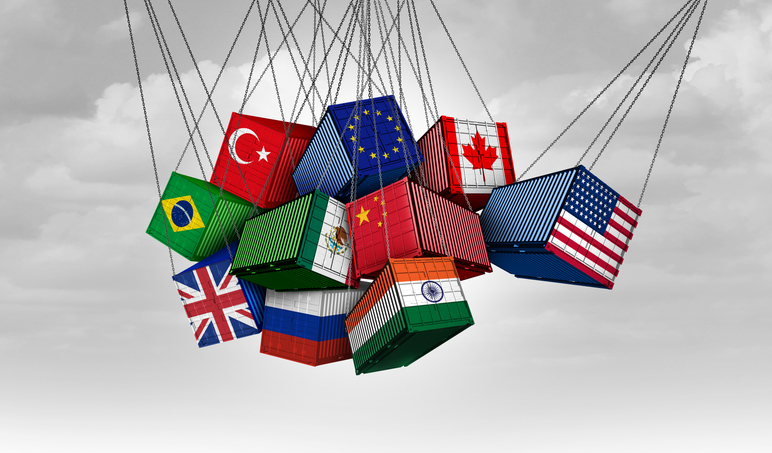Tariffs Prolong the Age of Uncertainty and Disruption

The Trump Administration has announced it will impose additional tariffs on China (on top of the several sets of already levied tariffs) since the country did not withdraw retaliatory tariffs it had slapped on the U.S. The additional tariffs — which would raise the total to at least 104 percent on Chinese goods coming to the U.S. — are slated to be effective Wednesday.
Since last week, when President Donald Trump imposed steep tariffs against countries around the world, including an additional 34 percent on China (which already had a 20-percent levy), markets have been volatile, with the S&P 500 approaching bear market territory on Monday. Trump has said he has no intention to remove tariffs until the trade deficits disappear.
“These tariffs seek to address the injustices of global trade, reshore manufacturing, and drive economic growth for the American people,” an April 2 White House statement says.
The New York Times on Monday reported, “President Trump’s trade war made investors increasingly pessimistic about the economy but he defended his global tariffs, saying those in place had already brought the United States billions of dollars in revenue. He also said that he would cease negotiations with China unless it withdrew its tariff plans.”
Institute for Supply Management® (ISM®) CEO Thomas W. Derry, says that he thinks the administration “is trying to make the case that all these conditions will incentivize Americans to buy American and incentivize companies to relocate their operations to the U.S. That remains to be seen. But what we know to be true is that Americans will pay more for everything, whether it’s domestically produced or sourced from a foreign destination.”
A Decade of Disarray
It’s the decade of uncertainty and volatility. In 2020, the coronavirus pandemic hit, spurring widespread supply chain disruption — sourcing issues, shipping delays, supply problems, and more. Now, there’s a trade war.
Before this decade, Derry says, “we had an unusual period of stability and consensus from the 1990s to the 2010s. And that was because there was one acknowledged superpower in the world: the U.S.” Also contributing to the stability: A widespread belief that opening up country markets and promoting international trade led to rising standards of living for people all around the world, he says.
But then there was pushback and a leaning toward nationalism. “I often say the Brexit vote was the first signal that the consensus was cracking,” Derry says. “And we’ve seen other instances since then.” For the U.S., the tariffs imposed by the Trump administration on Canadian softwood lumber in 2017 — the first tariffs — perhaps were the impetus. Those were followed in 2018 by tariffs on China, aluminum and steel.
“It made the weaponization of tariffs OK again,” Derry says.
Until recent years, the U.S. didn’t employ tariffs as a tactic. “We had moved beyond that,” Derry says. “Now it’s back. And it’s not just the U.S. Other countries are doing it in their own bilateral trade relationships, for better or for worse. And I would say worse. It’s now something that countries feel like they can now pull out and use.”
Manufacturing Has Changed
The White House statement says, “These tariffs are central to President Trump’s plan to … put America on a path to a new golden age. This builds on his broader economic agenda of energy competitiveness, tax cuts, no tax on tips, no tax on Social Security benefits, and deregulation to boost American prosperity.”
The imposition of tariffs, despite Trump’s statements to the contrary, are generally expected to increase customer and consumer prices for many goods, including groceries and autos.
“We’ll pay more. We’ll have reduced choice,” Derry says. “And it’s an open question as to whether manufacturing jobs are coming back.”
The White House statement states, “(I)ncreasing domestic manufacturing is critical to U.S. national security. … In 2023, U.S. manufacturing output as a share of global manufacturing output was 17.4 percent, down from 28.4 percent in 2001.” It adds, “ ‘Made in America’ is not just a tagline — it’s an economic and national security priority of this Administration. The President’s reciprocal trade agenda means better-paying American jobs making beautiful American-made cars, appliances, and other goods.”
There is no returning to the “manufacturing glory days” of the 1990s, Derry says, or even of the early 2000s. Manufacturing is different than it was 30 years ago, he says. Robotics and automation have changed the sector. “There are fewer jobs and they are different from the jobs that existed 30 years ago,” he says.
“In my opinion, it’s misguided to believe that we’re headed back to the halcyon days of a manufacturing-driven Midwest. The world moves on. It does not stand still.”

